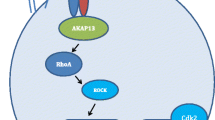Abstract
It was found that both normal human myometrium and uterine leiomyoma contain several glycosaminoglycans. In contrast to many normal and tumour tissues the amount of hyaluronic acid is very low and the proportional amount of sulphated glycosaminoglycans is distinctly higher. It is of interest that heparan sulphate is the major glycosaminoglycan component both in normal myometrium, and in leiomyoma. The amount of hyaluronic acid in myometrium and in the leiomyoma is very low. No significant change in hyaluronate content was observed during the tumour growth. In contrast to that the amount of some sulphated glycosaminoglycans (heparan sulphate, keratan sulphate, chondroitin sulphates and heparin) distinctly increased. It is suggested that some of the GAGs participate in the creation of a storage depot for biologically active molecules (growth factors, enzymes) which are thereby stabilized and protected. Hydrolytic degradation of some GAGs may result in the release of some cytokines which may promote the tumour growth and stimulate collagen biosynthesis by tumour cells.
Similar content being viewed by others
References
Jackson RL, Bush SJ, Cardin AD: Glycosaminoglycans: Molecular properties, protein interactions, and role in physiological processes. Physiol Rev 71: 481–539, 1991
Iozzo RV: Proteoglycans and neoplasia. Cancer Metastasis Rev 7: 39–50, 1988
Baäkowski E, Rzeczycki W, Nowak HF, Jodczyk KJ: Decrease of collagen biosynthesis ability of rat kidney fibroblasts transformed with SV‐40 virus. Mol Cell Biochem 20: 77–83, 1978
Kamine J, Rubin H: Coordinate control of collagen synthesis and cell growth in chick embryo fibroblasts and the effect of viral transformation on collagen synthesis. J Cell Physiol 92: 1–12, 1977
Levinson W, Bhatnagar RS, Liu TZ: Loss of ability to synthesize collagen in fibroblasts transformed by Rous sarcoma virus. J Natl Cancer Inst 55: 807–810, 1975
Klagsbrun M: The decreased synthesis of chondroitin sulfate containing extracellular proteoglycans by SV‐40 transformed Balb c/3T3 cells. Biochim Biophys Acta 451: 170–183, 1976
Pacifici M, Boettiger D, Roby K, Holtzer H: Transformation of chondroblasts by Rous sarcoma virus and synthesis of the sulfated proteoglycan matrix. Cell 11: 891–899, 1977
Sobolewski K, Baäkowski E: Heterogeneity of collagen isolated from methylcholanthrene induced sarcoma. Acta Biochim Polon 31: 317–328, 1984
Asokan R, Puvanakrishnan R, Ravichandran LV, Kokila V, Reddy GK, Dhar SC: Purification and characterization of collagens from rat fibrosarcoma induced by 3‐methylcholanthrene. Mol Cell Biochem 121: 99–107, 1993
Baäkowski E, Sobolewski K, Ayad S, Gadher S, Woolley DE: Rat fibrosarcoma as a source of stable co‐polymer of type I and type III collagens. Pathobiology 62: 160–164, 1994
Cechowska‐Pasko M, Pałka J, Baäkowski E: Decrease in the glycosaminoglycan content in the skin of diabetic rats. The role of IGF‐I, IGF‐binding proteins and proteolytic activity. Moll Cell Biochem 154: 1–8, 1996
Snow AD, Kisilevsky R, Stephens CH, Anastassiades T: Electrophoresis of glycosaminoglycans isolated from normal human plasma. Direct evidence for the presence of a heparinlike molecule. Biomed Biochim Acta 46: 537–546, 1987
Svejcar J, van Robertson W: Micro separation and detremination of mammalian acidic glycosaminoglycans. Anal Biochem 18: 333–350, 1967
Carney SL: Proteoglycans. Proteoglycan constituent analytical techniques. The Elson‐Morgan assay for hexosamine. In: MF Chaplin, JF Kennedy, (eds). Carbohydrate Analysis. A practical appropach. Oxford‐Washington DC: JRL Press, 1986, pp 97–142
Bitter T, Muir HM: A modified uronic acid carbazole reaction. Anal Biochem 4: 330–334, 1962
Prockop DW, Udenfriend S: A specific method for analysis of hydroxyproline in tissues and urine. Anal Biochem 1: 228–239, 1960
Murata K, Motayama T, Kotake C: Changes of collagen types in various layers of the human aorta and their changes with the atherosclerotic process. Atherosclerosis 60: 251–262, 1986
Baäkowski E, Sobolewski K, Romanowicz L, Chyczewski L, Jaworski S: Collagen and glycosaminoglycans of Wharton's jelly and their alterations in EPH‐gestosis. Eur J Obst Gyn Reprod Biol 66: 109–117, 1996
Cabrol D, Dallot E, Cedard L, Sureau C: Pregnancy‐related changes in the distribution of glycosaminoglycans in the cervix and corpus of the human uterus. Eur J Obstet Gynecol Reprod Biol 20: 289–95, 1985
Taipale J, Keski‐Oja J: Growth factors in the extracellular matrix. FASEB J 11: 51–59, 1997
Vlodavsky I, Korner G, Ishai‐Michaeli R, Bashkin, Bar‐Shavit R, Fuks R: Extracellular matrix‐resident growth factors and enzymes: possible involvement in tumour metastasis and angiogenesis. Cancer Metastasis Rev 9: 203–226, 1990
Kjellen L, Lindahl V: Proteoglycans: Structures and interactions. Ann Rev Biochem 60: 443–475, 1991
Nakanishi K, Kawai T, Suzuki M, Shinmei M: Glycosaminoglycans in pleomorphic adenoma and adenoid cystic carcinoma of the salivary gland. Arch Pathol Lab Med 114: 1227–1231, 1990
Ehara T, Katsuyama T: Characterization of glycoconjugates found in granular cell tumors with special reference to keratan sulfate. Wirchows Arch B Cell Pathol 58: 221–227, 1990
Lapis K, Kavalsky I, Jeney A, Pogany G, Molnar G, Repassy D, Szecseny A, Karacsonyi S: Alterations of glycosaminoglycans in human liver and kidney tumors. Tokai J Exp Clin Med 15: 155–165, 1990
Nagasawa S: Effect of glycosaminoglycans on the growth of cultured tumor cells. J Osaka Dent Univ 27: 121–133, 1993
Vlodavsky I, Eldor A, Haimovitz‐Friedman A, Matzner Y, Ishai‐Michaeli R, Lider 0, et al.: Expression of heparanase by platelets and circulating cells of the immune system: Possible involvement in diapedesis and extravasation. Invasion‐Metastasis 12: 112–127, 1992
Moczar M, Caux F, Railly M, Berthier 0, Dore JF: Accumulation of heparan sulfate in the culture of human melanoma cells with different metastatic ability. Clin Expi Metastasis 11: 462–471, 1993
Timar J, Ladanyi A, Lapis K, Moczar M: Differential expression of proteoglycans on the surface of human melanoma cells characterized by altered experimental metastatic potential. Am J Pathol 141: 467–474, 1992
Nakanishi H, Oguri K, Yoshida K, Itano N, Takenaga K, Kazama T et al.: Structural differences between heparan sulphates of proteoglycan involved in the formation of basement membranes in vivo by Lewis‐lung‐carcinoma‐derived cloned cells with different metastatic potentials. Biochem J 288: 215–224, 1992
Author information
Authors and Affiliations
Rights and permissions
About this article
Cite this article
Wolańska, M., Sobolewski, K., Drożdżewicz, M. et al. Extracellular matrix components in uterine leiomyoma and their alteration during the tumour growth. Mol Cell Biochem 189, 145–152 (1998). https://doi.org/10.1023/A:1006914301565
Issue Date:
DOI: https://doi.org/10.1023/A:1006914301565



